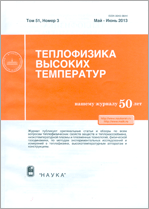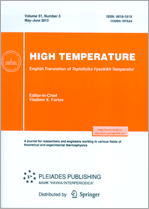|
|
Teplofizika vysokikh temperatur, 2012, Volume 50, Issue 1, Pages 65–73
(Mi tvt230)
|
 |
|
 |
This article is cited in 9 scientific papers (total in 9 papers)
Thermophysical Properties of Materials
Computer simulation of liquid zinc
D. K. Belashchenko
Moscow Institute of Steel and Alloys, National Research Technological University, Moscow, Russia
Abstract:
An embedded atom model potential for zinc has been developed, which makes it possible to calculate liquid zinc properties both under normal pressure and in strongly compressed states using the molecular dynamics method. In order to calculate the potential, the data on density, energy, and compressibility of liquid zinc and the data on shock compression of zinc were used. Pair contribution to the potential and the embedding potential are represented by analytical functions. Liquid zinc properties are calculated at temperatures up to $1500$ K. The values of energy, bulk compression modulus, and self-diffusion coefficient, as well as pair correlation functions at $T<1000$ K, agree well with the experiment. The electron contribution to the thermal capacity at those temperatures is not high. Zinc models are constructed for densities up to $15.86\text{ g/cm}^3$ and pressures up to $773$ GPa. Zinc models melt in the case of shock compression at compression rates of $V/V_0<0.7$ and temperatures above $1900$ K. A significant contribution of electron excitation energy to the zinc energy is observed at temperatures above $20000$ K. The estimated average surplus thermal capacity of electrons at $30000$–$50000$ K is $\sim12$ J/mole K. Discrepancies between the molecular dynamic calculation and the Gruneisen model at low temperatures are relatively low; however, they rise as temperature increases. A series of zinc nanocluster models with magic sizes of $55$ and $147$ atoms is constructed. The clusters have an amorphous structure with slightly lower energy than that of icosahedral or cuboctahedral configuration, after cooling from $600$ to $10$ K. The surface energy of zinc at $T=0$ calculated based on the dependence of energy of clusters on size is $1.3\text{ J/m}^2$.
Received: 14.02.2011
Citation:
D. K. Belashchenko, “Computer simulation of liquid zinc”, TVT, 50:1 (2012), 65–73; High Temperature, 50:1 (2012), 61–69
Linking options:
https://www.mathnet.ru/eng/tvt230 https://www.mathnet.ru/eng/tvt/v50/i1/p65
|


| Statistics & downloads: |
| Abstract page: | 261 | | Full-text PDF : | 91 | | References: | 47 |
|





 Contact us:
Contact us: Terms of Use
Terms of Use
 Registration to the website
Registration to the website Logotypes
Logotypes








 Citation in format
Citation in format 
